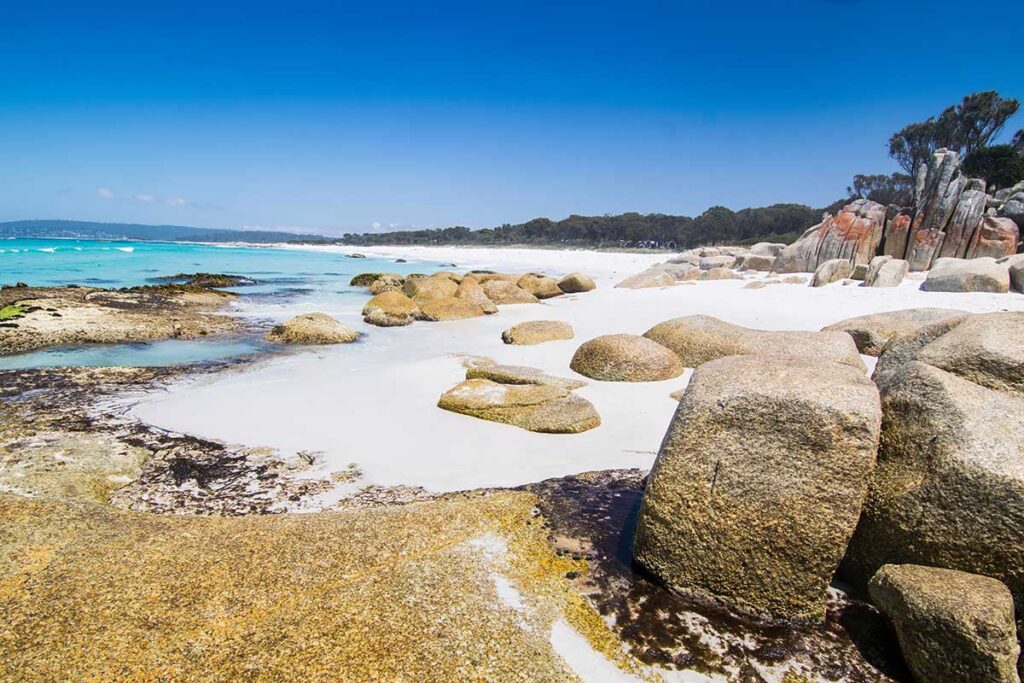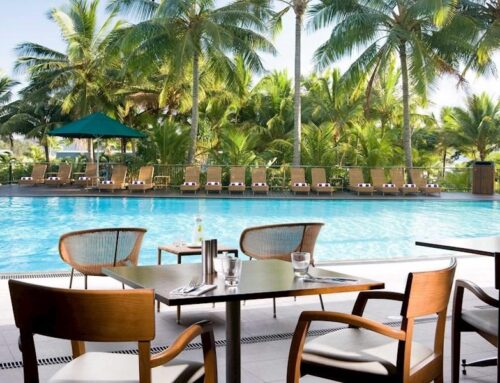Top 15 Things to See in Tasmania
Tasmania – The Ultimate Bucket List
Welcome to the ultimate guide for experiencing Tasmania! This island state of Australia is a treasure trove of natural beauty, rich history, and vibrant culture that awaits exploration. From the rugged peaks of Cradle Mountain to the pristine waters of Wineglass Bay, Tasmania’s landscapes are as diverse as they are breathtaking.
In the bustling city of Hobart, you’ll find a harmonious blend of heritage and modern lifestyle, with historic sites alongside contemporary art museums. Tasmania’s culinary scene is equally impressive, boasting an array of fresh local produce and world-class seafood. But it’s not just about the cities and food; the island also offers countless opportunities for outdoor adventures.
This article has been carefully crafted to help you discover the best Tasmanian things to do. Whether you’re a nature lover, history buff, foodie, or adventure enthusiast, there’s something for everyone on this ultimate bucket list. So, let’s embark on this exciting journey and uncover the top experiences that make Tasmania a must-visit destination. Get ready to tick off these bucket list items and create unforgettable memories in the heart of Tasmania.
1. Hobart is Tasmania’s capital city, known for its charming blend of heritage, lifestyle, scenery, and culture.
Tasmania’s capital, Hobart, is an intoxicating mix of the old and new. The city’s rich history is evident in its beautifully preserved colonial architecture, particularly in areas like Battery Point. Salamanca Market, held every Saturday, is a must-visit for its vibrant atmosphere and local produce.
The city is also home to MONA, the Museum of Old and New Art, which hosts some of the most provocative contemporary art in the world. For nature lovers, Mount Wellington offers stunning panoramic views over the city and beyond. Hobart’s food scene thrives, with fresh seafood and local produce taking centre stage.
The city’s waterfront is lively, with many restaurants, bars, and cafes. Hobart is also the gateway to southern Tasmania’s best travel experiences, including historic Port Arthur and the rugged beauty of Bruny Island. Despite its small size, Hobart has a unique charm and a big heart, making it a must-visit for any Tasmania itinerary.
2. Climb Mount Wellington for an unforgettable view of Hobart and beyond.
Mount Wellington, also known as Kunanyi, is a remarkable natural landmark that towers over Hobart. The journey to its summit is an adventure in itself, offering a variety of hiking and climbing experiences and amazing views for every level of outdoor enthusiast.
One popular route is the circuit walk from The Springs, which comprehensively explores the mountain’s unique landscape. For those seeking a more challenging endeavour, the mountain’s dolerite rock formations offer an exhilarating rock climbing experience with stunning views of Hobart 1400m below.
Best walks around Mount Wellington
The Zig Zag Track Lookout Loop, The Springs to Sphinx Rock Loop, and The Springs to the Pinnacle are some of the other favourite walks on Mount Wellington. Each trail presents its own unique perspective of the mountain’s diverse ecology and breathtaking vistas.
Reaching the summit is a rewarding experience, with panoramic views that extend over Hobart and far beyond. You can climb all the way to the official “top” of the mountain and ascend the little promontory that marks the summit. Whether you’re a seasoned hiker or a casual nature lover, climbing Mount Wellington is a must-do experience when visiting Tasmania.
3. Explore Cradle Mountain, one of Tasmania’s most iconic natural attractions, perfect for hiking and wildlife spotting.
Cradle Mountain National Park is one of Tasmania’s crown jewels, offering some of the country’s most stunning landscapes. With its alpine heathland, ancient rainforests, and rugged mountains, the area is a haven for nature lovers.
The iconic Cradle Mountain forms the centrepiece of the Cradle Mountain National Park, Lake St Clair National Park, part of the Tasmanian Wilderness World Heritage Area. The famous Overland Track, a six-day trek that takes you through some of Tasmania’s most breathtaking scenery, starts here.

Cradle Mountain Wildlife
The park is home to diverse wildlife, including wombats, echidnas, and Tasmanian devils. Plenty of shorter walks, such as the Dove Lake Circuit, offer stunning views of Cradle Mountain. The area is known for its beautiful summer wildflowers and stunning autumn colours.

Despite its remote location on Cradle Mountain, there are good facilities, including a visitor centre and accommodation options. Exploring Cradle Mountain is an unforgettable experience, immersing you in the heart of Tasmania’s wild beauty.
4. Wineglass Bay – stunning bay in Freycinet National Park, renowned for its beauty.
Wineglass Bay is one of the most iconic destinations in Tasmania, located within the stunning Freycinet National Park. This striking bay is renowned for its crystal-clear waters and curvaceous white beach, which forms a perfect arc beneath the Hazards mountains. It is considered one of the top ten beaches in the world and offers visitors an unparalleled coastal experience.
The journey to the bay is part of the adventure. It’s an uphill trek to the Wineglass Bay lookout, but the effort is rewarded with a breathtaking view over the famous arc of white beach, green forested isthmus, and blue water. The coastal scenery here is spectacular, with the park’s red and pink granite formations adding to the natural beauty.
Those seeking more than a viewing point can descend to the beach. Here, you can enjoy the pristine sands and clear waters up close. Wander white sand beaches lining the calm blue waters of Freycinet National Park on Tasmania’s east coast. Head out on one of the state’s famous walking tracks for a true adventure. The bay is also accessible by water, with cruises offered on the Schouten Passage II. Visitors can experience the exquisite beauty of Wineglass Bay without the crowds. Visiting Wineglass Bay is not merely about seeing a beautiful place but truly experiencing one of nature’s masterpieces.
5. Tasmania’s East Coast
Tasmania’s East Coast is a treasure trove of stories, encounters, and rich experiences. It’s renowned for its spectacular landscapes, pristine white-sand beaches, and charming little townships that make every moment memorable. The area offers a rejuvenating experience with its sea-salted air, quiet bays, sandy shores, and granite headlands, making it a perfect destination for those seeking natural beauty and tranquillity.
6. West Coast Wilderness Railway journey
The West Coast Wilderness Railway journey is a captivating voyage that transcends mere transportation, offering an enriching heritage experience that breathes life into history. Situated in Tasmania, the railway operates full and half-day steam train tours along a historic 35km track, connecting the towns of Queenstown and Strahan.
This isn’t just any railway; it’s a faithful reconstruction of the Mount Lyell Mining and Railway Company’s original track, offering passengers a glimpse into Western Tasmania’s prosperous past in mining. As the train gently meanders through the cool-temperate rainforest blanketing Tasmania’s west coast, onboard guides recount tales of hardship and resilience, adding depth to the scenic journey.
The ride takes passengers through gorges, up steep inclines, past historical markers, and to incredible wilderness vantage points. The train makes periodic stops, allowing passengers to step out and fully appreciate the breathtaking Tasmanian scenery.
A highlight of the journey is the five-hour journey from Macquarie Harbour to the ancient rainforest and mountains of Tasmania’s rugged west coast. The West Coast Wilderness Railway encapsulates many stories that reflect the ingenuity, resilience, and determination that shaped the West Coast.
7. Binalong Bay and the Bay of Fires
Binalong Bay and the Bay of Fires, nestled on the northeastern coast of Tasmania, offer a captivating display of nature’s splendour. Binalong Bay is the welcoming gateway to the Bay of Fires, famed for its pristine white sandy beaches, crystal-clear waters, and the iconic orange-tinged granite boulders that line the shore. The intriguing name “Bay of Fires” was coined by early European explorers who spotted Aboriginal fires along the coastline. From the stunning sunrises to the tranquil evenings, visiting Binalong Bay and the Bay of Fires is a serene escape into the heart of nature’s beauty.

The Bay of Fires unfurls over 50 kilometres from Binalong Bay in the south to Eddystone Point in the north, presenting a vast and unspoiled coastline for visitors to explore. Here, one can witness wildlife in its natural habitat; dolphins playfully surf the waves, whales breach in the distance, and various bird species flutter above.
Binalong Bay and the Bay of Fires activities
Outdoor enthusiasts will find plenty to do in Binalong Bay, with swimming, surfing, bushwalking, and fishing opportunities. A guided walk through the Bay of Fires is an enriching experience, offering insights into the area’s unique flora, fauna, and history.
For those seeking a more immersive nature experience, camping under the star-lit sky on one of the many secluded beaches is popular. The Bay of Fires is also a diver’s paradise, boasting some of Tasmania’s best snorkelling and diving sites, with vibrant marine life and intriguing underwater caves.
8. See the Maria Island Painted Cliffs
Maria Island, located off the eastern coast of Tasmania, is home to one of nature’s most stunning creations – the Painted Cliffs. These sandstone cliffs, sculpted by mineral-rich water and wind erosion over thousands of years, showcase an array of vibrant hues and intricate patterns that truly live up to their name.
The Painted Cliffs are best viewed at low tide when the full extent of their beauty is revealed. The swirling patterns, painted in red, orange, and yellow iron oxide shades, create a stunning natural art display that is a photographer’s dream.
Walking tracks along the cliff base allow visitors to appreciate the fascinating formations up close. You’ll marvel at the awe-inspiring honeycomb weathering and the wave-like patterns etched into the stone.
While the cliffs are undoubtedly the star attraction, the journey to them is equally captivating. The walk from Darlington, the main settlement on Maria Island, takes you past picturesque beaches and native woodland, offering ample opportunities for wildlife spotting.
Visiting the Painted Cliffs is about admiring the natural beauty and soaking up Maria Island’s tranquillity. Whether you’re a nature lover, a photography enthusiast, or a history buff, visiting the Painted Cliffs promises to be an unforgettable experience.
9. Cruise through the Franklin-Gordon Wild Rivers National Parks
Embarking on a cruise through Franklin-Gordon Wild Rivers National Parks is an awe-inspiring journey, taking you into the untouched wilderness of Tasmania. This national park is part of Tasmania’s World Heritage Area, boasting a landscape of rugged peaks, deep gorges, and wild rivers flowing through ancient rainforests.
As you cruise along the Gordon River, you’ll be treated to breathtaking views at every turn. The river’s dark, tannin-stained waters reflect the rainforest’s mirror-like images, creating a surreal and captivating scene.

The cruise offers stunning views and provides a fascinating insight into Tasmania’s history. Stories of early explorers, convicts, and pioneering settlers who navigated these waterways come to life as you glide along the river.
One of the highlights of the Gordon River cruise is a stop at Heritage Landing, where you can take a short walk through the ancient rainforest. The towering Huon pines, some over 2000 years old, are impressive.
In addition to the sights, the abundant wildlife that inhabit the area adds to the experience. From sea eagles soaring above to platypuses frolicking in the river, wildlife spotting has plenty of opportunities.
10. Learn About Tasmania’s History at Port Arthur Historic Site
Port Arthur Historic Site, located on the Tasman Peninsula of Tasmania, is a place of profound historical significance. In 1830, it began as a small timber station, but it quickly grew in importance and became a penal settlement within the colonies. Shipbuilding was introduced here, marking a major milestone in its development.
Port Arthur is globally significant and recognized as a UNESCO World Heritage Site, underlining its value and importance. Whether you’re a history enthusiast or a casual visitor, learning about Tasmania’s history at the Port Arthur Historic Site is an enriching and enlightening experience.
Port Arthur is not just a historic site; it’s a living testament to Australia’s complex past. It offers a compelling narrative of the country’s convict history, making it a must-visit for those interested in understanding Tasmania’s roots. The town was a former convict settlement, which adds a layer of intrigue and depth to its history.
The site spans over 40 hectares and houses more than 30 historic buildings, each telling its own story of the past. Visitors can immerse themselves in this history through interactive exhibits, which bring Australia’s early convict history to life.
11. Play Golf on one of the World’s Most Scenic Courses
Tasmania, Australia’s island state, boasts some of the world’s most scenic golf courses. One such course is Cape Wickham Links, located on King Island. It offers a rare and dramatic mix of coastal holes. The ocean-side location makes it incredibly picturesque, with spectacular views at every turn.
Barnbougle Dunes is another must-visit golf course in Tasmania. Situated in Bridport, the course is renowned for its rolling dunes and stunning sea views. It’s not just the views that impress here but also the challenge the course presents, making it a favourite among golf enthusiasts.
The Lost Farm Barnbougle Golf Course is an equally impressive sister course to Barnbougle Dunes. It’s a unique course that weaves through the wild coastal dunes of Tasmania’s northeast, offering players breathtaking views and challenging gameplay.
Ocean Dunes is another top-ranking golf course in Tasmania. This course offers a thrilling experience with stunning ocean views and challenging holes. It promises to test your skills while enchanting you with its beauty.
Ratho Golf Course is Australia’s oldest golf course and carries a rich history. Its simple layout takes players back to the game’s roots, and the surrounding farmland scenery provides a peaceful backdrop for a round of golf.
All these golf courses in Tasmania offer a game and an experience, combining the beauty of the natural landscape with the thrill of the sport.
12. Flinders Island
Flinders Island, one of the major islands in Tasmania, is a haven for adventurous souls. Its rugged landscapes and pristine beaches make it an ideal destination for nature lovers. The island offers a wide range of activities, from bushwalking and birdwatching to fishing and fossicking.
With its rich wildlife, including wombats and wallabies, Flinders Island provides intimate encounters with nature that will leave you in awe. Moreover, the island’s local cuisine promises a culinary delight featuring fresh seafood and locally grown produce. Whether you’re seeking tranquillity or thrill, Flinders Island guarantees an unforgettable Tasmanian experience.
13. Climb “The Nut”
“The Nut” is a remarkable geological feature in the historic town of Stanley, Tasmania. This sheer-sided bluff is all that remains of an ancient volcanic plug, and it provides breathtaking panoramic views over Bass Strait and the quaint village below.
Climbers can ascend “The Nut” via a challenging steep track or by taking a leisurely chairlift ride to the top. Once atop, the plateau offers picturesque walking tracks where you can soak in the stunning coastal scenery and possibly spot some local wildlife. From its intriguing history to its unrivalled vistas, “The Nut” is an iconic landmark that adds a dash of adventure to your Tasmanian journey.
14. Traverse the Tamar Valley Wine Region
Exploring the Tamar Valley Wine Region is an absolute delight for wine connoisseurs and nature enthusiasts alike. Nestled in northern Tasmania, this fertile region is renowned for its exceptional cool-climate wines, especially its world-class Pinot Noir and Chardonnay.
As you travel through the picturesque landscapes, ambling along vineyard-lined routes, you’ll discover charming cellar doors offering tastings that showcase the valley’s rich terroir. Surrounded by rolling hills and serene riverscapes, the Tamar Valley Wine Region promises exquisite wines and captivating beauty that will make your Tasmanian adventure truly unforgettable.
15. Richmond Bridge – Australia’s oldest bridge
The Richmond Bridge, located in Tasmania, is a significant piece of Australian history as it is the oldest stone span bridge in the country. Initially named Bigges Bridge, convicts constructed it using sandstone quarried at Butchers Hill between 1823 and 1825. The bridge was built primarily for the movement of military, police, and convicts between Hobart and Port Arthur.
Today, it continues to be used and is recognized as an outstanding historic place, added to the Australian National Heritage List in 2005. The area around the bridge offers beautiful parklands, making it a historical landmark and a picturesque spot for visitors and locals alike.
Tasmania takeaway
Tasmania is a top destination due to its rich history, stunning landscapes, and unique attractions. It boasts rugged wilderness areas like Cradle Mountain-Lake St Clair National Park, which is teeming with indigenous wildlife and offers breathtaking views. Visitors can also explore the Museum of Old and New Art (MONA), which houses thought-provoking contemporary works alongside ancient artefacts.
Couple this with Tasmania’s thriving food and wine scene, which reflects the island’s pure environment—fresh seafood from clean waters, premium craft beers, and world-class cool-climate wines make Tasmania a gastronomic paradise.
Whether you’re a history enthusiast, nature lover or foodie, Tasmania ticks all the boxes for an unforgettable visit.







